Below are some examples of what and what not to aim for when shooting your pet:
Scroll down to view our Top 10 Tips
Get as close as possible! |
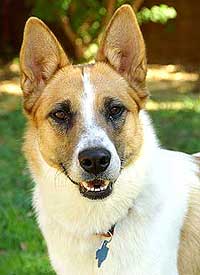
Good:
This is a perfect example of an up close, straight-on head shot.
|
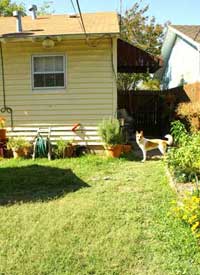
Bad:
Although this image might have been taken at a reasonably high resolution, by the time we crop away all the excess background to focus in on just the dog, the image will appear grainy and pixilated. (Mouse over image to see.) |
| Pay attention to angle! |

Good:
This is a stunning three-quarters shot. It is up close, and both eyes are visible. It is also great because this pretty girl's personality is captured with a big smile.
|
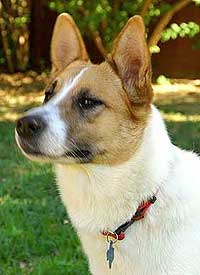
Bad:
This shot does not do as much justice to this pretty dog as the previous shot. Her right eye can barely be seen, and this creates a less flattering photo. Also, the eye that is showing is halfway closed. While we can work to open eyes up a bit, its always best to have them as open as possible. |
| Watch out for glow eye! |
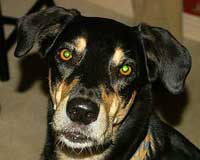
Good:
Here is an example of glow eye that is easy to fix. While the pupils are a glowing shade of green rather than black, their shape is defined, and if you look closely you can see small while highlights. Fixing this glow eye would be a breeze for us!
|
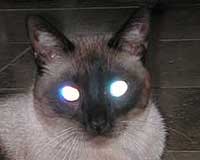
Bad:
This is a classic example of really bad glow eye. The eyes are just big glowing circles. There are no pupils or highlights defined, and therefore there is nothing to work with when trying to fill in the missing elements. |
| Some more good examples... |
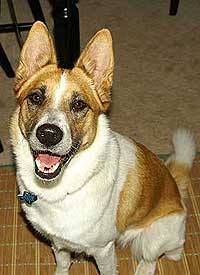
Good:
It is important to realize how different angles can create a different mood for the photograph. While the previous head shots of this girl Ruby are somewhat more elegant, shooting from a slightly higher angle in this case creates a more fun and whimsical pose. |

Good:
This picture does a great job of capturing the dog's full body. The hands in the picture can be easily removed, because they do not cover any of the dog's important features. |
Top 10 tips for taking great pet photos:
- Get as close as possible.
- Consult your camera's user manual to set your camera to shoot at the highest quality. With some cameras, this will mean setting it to "large file." Other, more complex cameras may give you options for resolution and file type. Choose a minimum of 300 dpi and "jpg" or "jpeg" for your file type. Read more about image resolution.
- Use toys or biscuits to get your pet to look in the desired direction.
- Have someone help you. When photographing pets, two humans are often better than one. Have a friend dangle toys or treats above your head while you shoot. Or, have them hold your pet's chest when trying to get a full body shot. Enlist someone your pet knows and is comfortable with. Pets can sometimes get nervous around new faces, and this won't help when you are trying to capture personality.
- Make sure your pet is in a comfortable environment. Like with unfamiliar people, pets can also get nervous in new environments. Or, if your pet is the more adaptable type, new places can distract him and you won't be able to get his attention in order to photograph him. The best solution is to photograph your pet in a place he is used to, so that he is neither nervous nor distracted.
- Pay attention to lighting situations. Avoid low light when photographing indoors. When photographing outside, avoid taking pictures during sunrise or sunset, as this can cause harsh shadows on your pet.
- Avoid using flash if possible. Not only can flash create glow eye on your pet, but it can also eliminate detail.
- Take a lot of pictures! The more you have to choose from, the more likely it is you will be happy with the photo you decide to use.
- Shoot from different angles. Shoot from above, below, from the side- angle can have a lot to do with the feel of a photograph, so try experimenting!
- Try exercising your dog before shooting. If you are after a fun, happy pose, try taking your pup for a jog around the block. Not only will it put your dog in a good mood, but panting makes dogs appear to be smiling.

Some more tips:
Get up close and personal!
The most important thing we can stress about taking your pet's photo is to get as close as possible. Your pet is to be the focal point of your picture, so let them take up as much of the image field as possible. The closer you can get to your pet, the more detail we will have to work with when creating your portrait. It is often these small details that make your pet unique, so get as close as you can when taking your pet's photo!
Set your camera to the highest resolution:
When using a digital camera, consult your manual to find out how to set it to take the highest quality photos. For those unfamiliar with resolution, it basically refers to the amount of detail in your image. Resolution is measured in dots per inch (dpi). The higher the number of dpi, the more detail and sharpness your image will hold. For example, an 800 dpi image will contain more detail than a 300 dpi image.
Positioning your pooch:
Get creative and shoot from different angles. Unusual angles can sometimes create a really interesting image. For example, if your pet is lying down on the ground, get down there with him! We are used to looking down at our pets, so getting a shot from their level can be interesting because it is not a view we see everyday.
Also, think about the angle of your pet's face. Do you want your pet to be looking straight on or would you rather capture a three-quarters shot? When opting for three-quarters, be careful that it doesn't end up looking more like a profile shot. This can sometimes happen when one eye is nearly missing from the shot.
Lighting is everything:
Try to take the picture in a well lit area, such as outdoors, especially on a bright overcast day, or in a sunlit room. Keep the sun behind your back and watch out for shadows (especially your own)! Make sure your pet is comfortable in the environment. If they are calm it will be much easier to capture the expression you want.
Everybody say "BISCUIT" on three:
Capturing emotion is what you're going for, right? Make silly noises to get their attention or have a friend assist you with a squeaky toy to perk up your pup's ears. Make sure your pet is comfortable in the environment. If they are calm it will be much easier to capture the expression you want. Take lots of shots! The more you have to chose from, the better chance you have of getting that one shot that really captures your pet's personality.
Glow eye:
When using a flash to photograph your pet, their pupils will often turn a glowing shade of red or blue. There are various levels of "glow eye," and some are easier to fix than others. To avoid glow eye all together, try taking your pet's photo without a flash. If you are working indoors and have to use a flash, do not worry! Take a look at our examples of glow eye above to see when we mean by different levels of glow eye. Sometimes, just the pet's pupil will be glowing. This is easy to fix because the pupil area is defined and easy to darken. If, however, your pet's entire eye is glowing and there is no indication of a pupil, you might want to try and re-shoot. It is important for us to know what color your pet's eyes are. We will do our best if that is the only picture you have to choose from, but eyes are a very important part of your pet's appearance, so try to get a defined pupil.
A tip for photographing black pets:
Black animals are inherently hard to photograph. Remember that the camera sees what you see, so if there are no highlights showing on your pet's coat, they won't show up in your shot. Black pets can often end up looking like solid black blobs with little definition when photographed. Therefore, try to place your pet in a contrasting area such as a white wall or in the grass outside. Always make sure the lighting is flattering to their features. In order to make sure you get some detail to show up, photograph your black pet in different lighting situations so that you can later choose which shows up the best. Also, keep in mind that flash photography usually eliminates detail, so this is probably not the best option when photographing black pets.
Professional photographs:
If you have a professional photograph you would like to send, you should consult with the photographer or the studio to attain a copyright release to send with the image.
We can work from any photograph, but remember that well focused shots where the pet is the largest thing in the photo will result in the best possible Pet Portrait of your special pal.
If you are wanting to e-mail your photos to us click here for tips on proper file size. |

